|
Your source for Recipes,
Diet Tips and Kitchen Tips
|
Pecan Pumpkin Pie
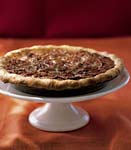 Active time: 45 min Start to finish: 4 1/2 hr (includes making dough and cooling) IngredientsFor pie shellPastry doughFor pumpkin filling3/4 cup canned solid-pack pumpkin 2 tablespoons packed light brown sugar 1 large egg, lightly beaten 2 tablespoons sour cream 1/8 teaspoon cinnamon 1/8 teaspoon freshly grated nutmeg For pecan layer3/4 cup light corn syrup 1/2 cup packed light brown sugar 3 large eggs, lightly beaten 3 tablespoons unsalted butter, melted and cooled 2 teaspoons vanilla 1/4 teaspoon finely grated fresh lemon zest 11/2 teaspoons fresh lemon juice 1/4 teaspoon salt 1 1/3 cups pecans (5 1/2 oz), chopped if desired Special equipment: pie weights or raw rice PreparationMake pie shell:Roll out dough on a lightly floured surface with a lightly floured rolling pin into a 13-inch round (1/8 inch thick), then fit into a 9-inch glass or metal pie plate. Trim edge, leaving a 1/2-inch overhang, then fold overhang under and crimp edge decoratively. Prick bottom and side of shell all over with a fork, then chill shell 30 minutes. While shell chills, put oven rack in middle position and preheat oven to 375°F. Line shell with foil and fill with pie weights, then bake until pastry is set and pale golden on rim, about 20 minutes. Carefully remove foil and weights and bake shell until pale golden all over, 6 to 10 minutes more. Cool on a rack. Make pumpkin filling: Whisk together pumpkin, brown sugar, egg, sour cream, cinnamon, nutmeg, and a pinch of salt in a bowl until smooth. Make pecan layer:Stir together corn syrup, brown sugar, eggs, butter, vanilla, zest, lemon juice, and salt in a bowl, then stir in pecans. Assemble and bake pie: Spread pumpkin mixture evenly in shell, then carefully spoon pecan mixture over it. Bake pie until crust is golden and filling is puffed, about 35 minutes. (Center will still be slightly wobbly; filling will set as it cools.) Cool completely on rack. Serve at room temperature. Cooks' note:Pie can be baked 4 hours ahead and kept, uncovered, at cool room temperature. Pie can also be baked 1 day ahead and chilled, loosely covered with plastic wrap. Reheat in a preheated 350°F oven until crust is crisp, about 15 minutes. Makes 8 to 10 servings.
Brussels Sprouts With Chestnuts
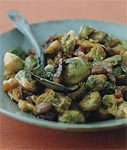 A touch of cream transforms this dish into a sumptuous side that exposes the luxurious character of this often homely vegetable. Ingredients2 tablespoons unsalted butter 3/4 teaspoon salt 1/2 teaspoon black pepper 1 1/4 cups water 2 lb Brussels sprouts, trimmed and halved lengthwise (8 cups) 1 cup heavy cream 2/3 cup bottled roasted whole chestnuts (4 oz), coarsely crumbled PreparationBring butter, salt, pepper, and 1 cup water to a boil over high heat in a deep 12-inch heavy skillet, then add Brussels sprouts and simmer, partially covered, stirring occasionally, until crisp-tender, 6 to 8 minutes. Remove lid and boil over moderately high heat until water is evaporated and sprouts are lightly browned, 3 to 4 minutes. Add cream and remaining 1/4 cup water and bring to a boil, stirring. Add chestnuts, then reduce heat and simmer, stirring occasionally, until heated through, about 2 minutes. Makes 8 servings.
Olive Oil And Garlic Whipped Potatoes
Ingredients1 large head of garlic 3 pounds yellow-fleshed potatoes such as Yukon Gold 1 cup extra-virgin olive oil 1/2 cup whole milk 1 1/2 teaspoons salt 1/4 teaspoon freshly grated nutmeg 1/4 teaspoon freshly ground black pepper PreparationPreheat oven to 400°F. Separate garlic head into cloves, discarding loose papery outer skin but keeping skin intact on cloves, and wrap tightly in foil. Roast garlic in middle of oven 30 minutes, or until soft. Unwrap garlic and cool slightly. Peel skins from each clove and on a plate with a fork mash garlic pulp until smooth. While garlic is roasting, peel potatoes and cut into 2-inch pieces. In a 4-quart kettle cover potatoes with cold salted water by 2 inches and simmer until potatoes are very tender, about 30 minutes. Drain potatoes in a colander and transfer to a large bowl. With a potato masher mash potatoes. Add garlic pulp, 3/4 cup oil, milk, salt, nutmeg, and pepper and with an electric mixer beat until smooth. Serve potatoes drizzled with remaining 1/4 cup oil. Makes 6 to 8 servings.
Spiced Cranberry Sauce
Can be prepared in 45 minutes or less. Ingredientsa 12-ounce bag of cranberries, picked over 1/2 cup honey 2 to 3 tablespoons firmly packed brown sugar, or to taste two 3-inch cinnamon sticks 6 whole cloves 1/4 teaspoon freshly grated nutmeg, or to taste 3/4 cup water PreparationIn a saucepan combine the cranberries, the honey, the brown sugar, the cinnamon sticks, the cloves, the nutmeg, and the water and simmer the mixture, covered, stirring occasionally, for 5 to 10 minutes, or until the cranberries have burst and the mixture is thickened. Transfer the sauce to a bowl and let it cool. The sauce may be made 2 days in advance and kept covered and chilled. Serve the sauce at room temperature. Makes about 2 1/4 cups.
Apple, Sausage, And Parsnip Stuffing With Fresh Sage
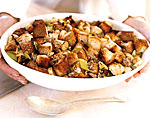 Ingredients Ingredients1 1 1/2-pound loaf sliced sourdough bread with crust, cubed 1 1/2 pounds sweet Italian sausages, casings removed 1 1/2 pounds hot Italian sausages, casings removed 6 cups chopped onions 2 cups chopped celery 3/4 cup (1 1/2 sticks) butter, divided 3 pounds Pippin or Granny Smith apples, peeled, cored, cubed 2 pounds parsnips, peeled, cubed 3/4 cup packed fresh sage leaves 1/2 cup low-salt chicken broth PreparationPreheat oven to 325°F. Bake bread cubes on 2 large rimmed baking sheets until lightly toasted, about 20 minutes. Sauté sausages in very large skillet over medium-high heat until cooked through, breaking into pieces with spoon, about 15 minutes. Using slotted spoon, transfer to large bowl; add bread. Add onions and celery to same skillet and sauté until golden brown, about 10 minutes; transfer to bowl with bread. Melt 1/4 cup butter in same skillet over medium-high heat. Add apples and sauté until tender, about 8 minutes; mix apples into stuffing. Melt 1/4 cup butter in same skillet over medium-high heat. Add parsnips and sauté until golden, about 10 minutes; mix into stuffing. Melt 1/4 cup butter in same skillet. Add sage and sauté until dark green, about 2 minutes. Mix sage and butter into stuffing. Season with salt and pepper. Butter 15x10x2-inch glass baking dish. Stuff turkey. Transfer remaining stuffing to prepared dish; drizzle with 1/2 cup chicken broth. Cover with foil. (Can be prepared 4 hours ahead. Cover and refrigerate.) Preheat oven to 350°F. Bake stuffing covered until heated through, about 1 hour. Uncover and bake until beginning to brown, about 10 minutes. Makes 12 servings.
Roast Turkey With Apple Cider Pan Gravy
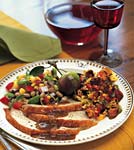 The milder flavor and softer aroma of Turkish bay leaves are preferable in this dish. IngredientsGravy base1 tablespoon butter 1 pound turkey necks and/or wings 1 pound onions, coarsely chopped 3 cups coarsely chopped celery 2 bay leaves 4 whole cloves 1/2 teaspoon salt 1/2 teaspoon ground black pepper 1/4 teaspoon ground cinnamon 1/8 teaspoon ground nutmeg 6 cups apple cider 3 cups low-salt chicken broth 1 8-ounce Granny Smith apple, finely chopped (including core and peel) 2 tablespoons honey 2 tablespoons apple cider vinegar Turkey1 16- to 17-pound turkey 1 large onion, halved, cut into 1-inch-wide wedges 1 Granny Smith apple, cut into 1-inch-wide wedges 6 bay leaves, crumbled 7 tablespoons butter, room temperature, divided 2 cups low-salt chicken broth PreparationFor gravy base:Melt butter in heavy large pot over medium-high heat. Add turkey parts; sauté 10 minutes. Add onions, celery, and bay leaves; sauté until onions are soft, about 8 minutes. Add cloves, salt, pepper, cinnamon, and nutmeg; stir 10 seconds. Add cider, broth, and apple; bring to boil. Reduce heat to low; simmer uncovered 45 minutes, stirring occasionally. Strain stock into medium saucepan. Discard solids. Stir honey and vinegar into gravy base. (Can be prepared 1 day ahead. Cool slightly. Refrigerate uncovered until cold, then cover and keep chilled.) For turkey:Set rack at lowest position in oven and preheat to 500°F. Rinse turkey inside and out; pat dry. Sprinkle main cavity generously with salt and pepper. Place onion wedges, apple wedges, and crumbled bay leaves in cavity. Starting at neck end, carefully slide hand between skin and breast meat of turkey to loosen skin. Rub 4 tablespoons butter over breast meat under skin. Place turkey on rack set in large roasting pan. Tuck wing tips under. Tie legs together loosely to hold shape. Rub remaining 3 tablespoons butter over outside of turkey. Sprinkle with salt and pepper. Place turkey in oven and immediately reduce oven temperature to 350°F. Roast turkey 1 hour; pour 1 cup chicken broth over turkey. Roast 1 hour, basting once with pan drippings. Pour 1 cup chicken broth over turkey. Roast until thermometer inserted into thickest part of thigh registers 175°F, basting once with pan drippings and covering turkey loosely with foil if browning too quickly, about 1 hour longer. Transfer turkey to platter; cover loosely with foil. Let turkey rest 20 to 30 minutes (internal temperature of turkey will increase 5 to 10 degrees). Pour pan juices into large measuring cup. Spoon fat off top of pan juices and discard. Return pan juices to roasting pan; add gravy base. Place roasting pan over 2 burners and bring gravy to boil. Reduce heat to medium-low and simmer until gravy is reduced to 31/4 cups, stirring occasionally and scraping up any browned bits, about 15 minutes. Season gravy to taste with salt and pepper. Strain gravy into bowl. Serve turkey with gravy. Makes 10 servings.
Pastry Dough
Active time: 15 min Start to finish: 1 1/4 hr Ingredients1 1/4 cups all-purpose flour 3/4 stick (6 tablespoons) cold unsalted butter, cut into 1/2-inch cubes 2 tablespoons cold vegetable shortening 1/4 teaspoon salt 2 to 4 tablespoons ice water Special equipment: a pastry or bench scraper PreparationBlend together flour, butter, shortening, and salt in a bowl with your fingertips or a pastry blender (or pulse in a food processor) until most of the mixture resembles coarse meal with some small (roughly pea-size) butter lumps. Drizzle evenly with 2 tablespoons ice water and gently stir with a fork (or pulse in processor) until incorporated. Squeeze a small handful: If it doesn't hold together, add more ice water, 1 tablespoon at a time, stirring (or pulsing) until just incorporated, then test again. (Do not overwork, or pastry will be tough.) Turn out mixture onto a lightly floured surface and divide into 4 portions. With heel of your hand, smear each portion once or twice in a forward motion to help distribute fat. Gather dough together with scraper and press into a ball, then flatten into a 5-inch disk. Chill dough, wrapped tightly in plastic wrap, until firm, at least 1 hour. Cooks' note: Dough can be chilled up to 1 day. Makes enough dough for 1 (9-inch) round tart.
Tropical Fruit Salsa
 Active time: 20 min Start to finish: 20 min Ingredients1 cup finely diced peeled firm-ripe papaya (from 1) 1/2 cup finely diced peeled firm-ripe mango (from 1) 1/3 cup finely chopped white onion 3 tablespoons chopped fresh cilantro 1 tablespoon fresh orange juice 1 tablespoon fresh lime juice 1/2 to 1 teaspoon minced fresh jalapeño chile, including seeds 1/2 teaspoon salt PreparationStir together all ingredients. Makes 2 cups.
Cilantro-Lime Chicken Fajitas with Grilled Onions
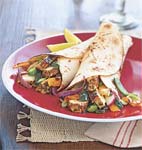 Ingredients Ingredients1 1/4 cups coarsely chopped fresh cilantro 3/4 cup olive oil 5 tablespoons fresh lime juice 2 1/2 teaspoons ground cumin 1 1/4 teaspoons ancho chile powder 6 skinless boneless chicken breast halves 3 large poblano chiles, seeded, cut into 3/4-inch-wide strips 3 large yellow bell peppers, cut into 3/4-inch-wide strips 2 red onions, sliced into 1/2-inch rounds 12 8-inch flour tortillas PreparationOptional toppings: purchased salsas, guacamole, sour cream, chopped fresh cilantro, sliced green onions, and chopped serrano chiles Prepare barbecue (medium heat). Puree first 5 ingredients in processor. Season marinade with salt and pepper. Place chicken in 13x9x2-inch glass baking dish. Pour 1/3 cup marinade over; turn to coat. Arrange poblanos, bell peppers, and onions on large rimmed baking sheet. Pour 1/2 cup marinade over; turn to coat. Sprinkle chicken and vegetables with salt and pepper. Reserve remaining marinade. Grill chicken until cooked through, about 7 minutes per side. Grill vegetables until tender, turning frequently, about 15 minutes for onions and 12 minutes for poblanos and bell peppers. Grill tortillas until charred, about 1 minute per side. Transfer chicken to work surface; slice crosswise into strips. Fill tortillas with chicken and vegetables; drizzle with reserved marinade. Serve with toppings. Makes 6 servings.
Guacamole
Can be prepared in 45 minutes or less. Ingredients2 ripe avocados (preferably California) 1 small onion, minced 1 garlic clove, minced and mashed to a paste with 1/2 teaspoon salt 4 teaspoons fresh lime juice, or to taste 1/2 teaspoon ground cumin 1 fresh or pickled jalapeño chili if desired, seeded and minced (wear rubber gloves) 3 tablespoons chopped fresh coriander if desired PreparationHalve and pit the avocados and scoop the flesh into a bowl. Mash the avocados coarse with a fork and stir in the onion, the garlic paste, the lime juice, the cumin, the chili, and the coriander. The guacamole may be made 2 hours in advance, its surface covered with plastic wrap, and chilled. Makes about 2 cups.
How to Eat Fewer Pesticides
Next time you're at the supermarket debating whether to pay more for a pint of organic strawberries than you do for your lunch — or deciding if you should choose that wilted organic celery over the crisp green conventional stalks — you might want to refer to the Environmental Working Group's new wallet-size Shoppers' Guide. The not-for-profit group lists the "Dirty Dozen" (the 12 fruits and veggies that are the most contaminated with pesticides) and the "Cleanest 12" (those that generally have the lowest amounts of pesticides). There have been some ratings revisions since the last Guide came out in October 2003. For instance, carrots are off the "bad" list now but lettuce is on it. Cauliflower has fallen from grace but cabbage has made the cut and is now on the "good list." Here are the full lists. The "Dirty Dozen" (starting with the worst)
- peaches
- apples
- sweet bell peppers
- celery
- nectarines
- strawberries
- cherries
- pears
- grapes (imported)
- spinach
- lettuce
- potatoes
The "Cleanest 12" (starting with the best)
- onions
- avocados
- sweet corn (frozen)
- pineapples
- mangoes
- asparagus
- sweet peas (frozen)
- kiwi fruit
- bananas
- cabbage
- broccoli
- papaya
To come up with its rankings, the Environmental Working Group looked at the results of close to 43,000 tests for pesticides on produce by the U.S. Department of Agriculture and the U.S. Food and Drug Administration. A computer analysis by the EWG found that consumers could reduce their pesticide exposure by nearly 90 percent by avoiding the most contaminated fruits and vegetables and eating the least contaminated instead. People who eat the "Dirty Dozen" will be exposed to an average of 15 different pesticides per day, says Richard Wiles, executive director of the Environmental Working Group, while eating from the "Cleanest 12" means you'll be exposed to less than two pesticides per day. So if produce from the "Dirty Dozen" is on your menu, it makes sense from a health standpoint to choose organic. Of course, health concerns aren't the only reasons people choose organic foods. It takes an enormous amount of fuel to make synthetic fertilizers, explains Wiles. "Conventional agriculture is very energy inefficient," he says. On the other hand, costly and polluting fuel is required to transport both conventional and organic fruit and vegetables from farms to grocery stores — produce is often shipped to the U.S. from as far away as New Zealand. So does this mean you're better off eating a locally grown nonorganic apple than an organic one from the other side of the world? Perhaps the solution, Wiles says, is to encourage local farmers to start growing organic crops. For example, begin by asking farmers whether they used pesticides on their apples, Wiles advises. "The more that local production can be moved toward organic, the better," he says. Meanwhile, even if you can't always afford or find organic produce, there are steps you can take to get rid of some of the pesticides on conventional produce. Since washing reduces pesticides by anywhere from one third to one half, thoroughly scrub and rinse everything, even produce that will be peeled. Then consider making yourself a pesticide-reduced dinner tonight. How does a menu of Guacamole, Tropical Fruit Salsa, and Cilantro-Lime Chicken Fajitas with Grilled Onions sound? To download a copy of the Shopper's Guide, visit http://www.foodnews.org.
Zuppa ~ Italian Comfort Food
As in many cultures, to an Italian, soup is comfort food. It is difficult not to feel better after enjoying a large, filling, bowl of soup. An old saying in Italy is that soup does seven things, or, La Zuppa fa sette cose. It is said to; quench your thirst, satisfy your hunger, fill your stomach, aid in your digestion, make your teeth sparkle, color your cheeks, and help you sleep. A clue to its very importance in Italian cuisine is reflected in the many different names given to different types of soup. In general, a minestra is a soup containing either rice or pasta along with vegetables, and possibly beans. A minestrina is a lighter broth soup, with just a little pasta or rice added, while minestrone would be a much heartier, thick soup. Zuppa is different from all these other soups as it has bread added, either to thicken, or as a condiment. Italians usually will eat soup as a first course instead of pasta or rice, or as a light evening meal if the large meal of the day was at lunch.Italian soups reflect the imagination and ingenuity that runs through all Italian cooking. Every soup is usually made from scratch with fresh ingredients, or leftover meats and vegetables from a previous meal. A soup can be as simple as a vegetable or two cooked in broth with a little rice or pasta added, or can be a complex multi-step procedure such as one containing homemade stuffed pastas in a fragrant meat broth. Grated cheese is usually served on the lighter broth based soups, while a drizzle of good extra virgin olive oil is used on thicker, heartier soups. Many Italian soups are typically served just warm, or at room temperature to allow the flavors to meld, as it is thought the true flavor is lost when serving it very hot. There are regional differences found in Italian soup recipes, just as there are in other categories of food. In the north, Emilia-Romagna in particular, stuffed pasta such as cappelletti, or Tortellini is served in a flavorful homemade meat broth. The soups in Tuscany and Umbria are more typical of old country recipes, and are heartier with beans, grains and bread used to fortify them such as Ribolitta, or Pappa Pomodoro. In the south, rich, thick Minestrone, or Lentil soups are common, while in the mountains, heavy, rich, full flavored soups, often fortified with bread and cheese can be found. Now that you understand the importance of soup in Italian cuisine, why not try one of the recipes offered here, or choose one from my Italian Soup Recipe Collection! Buon Appetito!
Nonna's Bean And Bread Soup
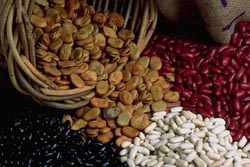 This soup recipe was handed down from my husband's Nonna, and expresses the traditional style of Italian peasant cooking where everything is used in a kitchen. : Serves 6 IngredientsThis recipe shows you that with just a few simple ingredients, it is possible to put together a tasty dish. 1/2 Package Dried Kidney Beans, Soaked Overnight 1 Onion, Finely Chopped Salt & Pepper to Taste 6 Slices Of Stale Italian Bread, Cut Into Pieces 3-4 Tablespoons Olive Oil Place the kidney beans in a pot, and just cover with water. Simmer until tender, adding more water if necessary to keep the beans covered. In a separate pan, heat the oil, and fry the onions until golden brown, Add this onion mixture to the kidney beans and their broth. Season with salt and pepper to taste. Place the bread slices in individual bowls, and pour the bean mixture on top. Let stand about 5 minutes on the burners set very low. Serve with an additional drizzle of olive oil, and enjoy! Buon Appetito!
|
|
 Active time: 45 min Start to finish: 4 1/2 hr (includes making dough and cooling)
Active time: 45 min Start to finish: 4 1/2 hr (includes making dough and cooling) A touch of cream transforms this dish into a sumptuous side that exposes the luxurious character of this often homely vegetable.
A touch of cream transforms this dish into a sumptuous side that exposes the luxurious character of this often homely vegetable. Ingredients
Ingredients The milder flavor and softer aroma of Turkish bay leaves are preferable in this dish.
The milder flavor and softer aroma of Turkish bay leaves are preferable in this dish.
 Ingredients
Ingredients